All you need to know about your products!

| 3DNews Vendor Reference English Resource - All you need to know about your products! |
||||||
 |
||||||
|
|
||||||
MSI GeForce FX 5950 UltraDate: 16/01/2004By:
The gone year 2003 has brought many interesting novelties in the field of 3D accelerators. We witnessed another coil of competition of today's flagship manufacturers of graphic chips: ATI and NVIDIA. Note that the competition is sheer enough and overstepped the limits of traditional comparison of "raw" performances of video cards. Even more than that, the year gave a chance to compete to driver writers rather than technical designers of chips. The former over-fulfilled their plans at releasing their creations. On the one hand, - yes, it is sad because now testers find it quite difficult to give a one-one estimation of performance of a graphic chip for most applications. On the other hand, that was quite expectable - the interpretations of DirectX 9.0 specifications among the parties are varied. That gives rise to numerous arguments and debates regarding NVIDIA video cards and the so-called driver cheats. From our part, we have repeatedly brought up the topic, and in today's review you, dear readers, will get an idea of how things are with the driver cheats in the most recent flagship solution from NVIDIA. 
The graphics board in question is made by MSI, a manufacturer very well-known in Russia, which enjoys a worthy reputation of a manufacturer that produces high-quality produce. The video card is built on NVIDIA's latest chip - NVIDIA GeForce FX 5950 Ultra (code name NV38). So, what is the new chip like? In fact, it is the same NV35 but with raised operating frequencies of the chip and memory. Production techniques become more polished with time - the yield rate for chips that provide guaranteed operation at higher speeds goes up. Therefore, why not to bring in a new chip on the market especially because ATI has done the same through releasing the ATI Radeon 9800XT which is an "overclock" of the previous flagship solution - Radeon 9800 Pro. But that seems to be the last "juice drops" squeezed out of both companies' graphic processors operating at the breaking point. New chips are already looming on the horizon, which we are so anxiously looking forward to. The solution of MSI being reviewed is the latest what NVIDIA can offer to date, as good as ATI Radeon 9800XT.
|
||||||||||||||||||||||||||||||||||||||||||||||||||||||||||||||||||||||||||||||||||||||||||||||||||||||||||||||||||||||||||||
| Radeon 9800 XT | GeForce FX 5900 Ultra | GeForce FX 5950 Ultra | |
| Code name | R360 | NV35 | NV38 |
| Process technology | 0.15 mk | 0.13 mk | 0.13 mk |
| Q-ty of transistors | ~107 mln (?) | 130 mln | 130 mln |
| Memory bus | 256 bit | 256 bit | 256 bit |
| Memory bandwidth | 23.4 GB/s | 27.2 GB/s | 30.4 GB/s |
| Pixel fillrate | 3.04 Gpixel/s | - Texelrate (Color+Z): 1800 texel/s - Z-rate (Z): 3600/s - Stencilrate: 3600/s - Texturerate: 3600/s |
- Texelrate (Color+Z): 1900 texel/s - Z-rate (Z): 3800/s - Stencilrate: 3800/s - Texturerate: 3800/s |
| Maximum antialiasing mode | 16x | 8x | 8x |
| Triangle transformation speed | 412 Mtriangles/s | 315 Mtriangles/s | 356 Mtriangles/s |
| AGP bus | 2x/4x/8x | 2x/4x/8x | 2x/4x/8x |
| Memory | 256 MB | 128/256 MB | 128/256 MB |
| Core speed | 412 MHz | 450 MHz | 475 MHz |
| Memory speed | 365 MHz (730 DDR) | 425 MHz (850 DDR) | 475 MHz (950 DDR) |
| Q-ty of vertex shader blocks | 4 | FP array | FP array |
| Pixel pipelines | 8 | 4 (8) | 4 (8) |
| Texture blocks per pipeline | 1 | 2 (1) | 2 (1) |
| Textures per texture unit | 8 | 16 | 16 |
| Vertex shader version | 2.0 | 2.0+ | 2.0+ |
| Pixel shader version | 2.0 | 2.0+ | 2.0+ |
| DirectX version | 9.0 | 9.0 | 9.0 |
| Antialiasing modes | Multisampling | Multisampling | Multisampling |
| Memory optimization | Hyper Z III+ | Optimized LMA II Color compression |
Optimized LMA II Color compression |
| Optimizations | SmartShader 2.1 SmoothVision 2.1 |
IntelliSample HCT | IntelliSample HCT |
| Q-ty of monitor outputs | 2 | 2 | 2 |
| Integrated RAMDAC | 2 x 400 MHz | 2 x 400 MHz | 2 x 400 MHz |
| Bits per color channel | 10 | 10 | 10 |
| Special features | Integrated TV coder; FullStream Adaptive filtering F-Buffer |
Integrated TV coder; Extended Programmability Adaptive filtering UltraShadow |
Integrated TV coder; Extended Programmability Adaptive filtering UltraShadow |
Hardly can we get more comments on the data presented in the table. We see a hackneyed overclocking of the previous-generation chip NVIDIA GeForce FX 5900 Ultra to frequencies 475 MHz / 475 MHZ (950 MHZ) from 450 MHZ / 425 MHz (850 MHz) in NVIDIA GeForce FX 5900 Ultra. As we see, although the running in of production and chip yield rate in NVIDIA have improved, the raise of frequencies proved to be not that high as many may have expected.
And nothing supernatural can be expected from the NVIDIA GeForce FX 5950 Ultra - the overclock is not so great to anticipate a radical re-alignment of forces in terms of competition with ATI. ATI is not second to NVIDIA at that - it also overclocks its cards in small bits, so the new flagship is unlikely to solve the major problem of low pixel performance typical of the FX family cards. However strange it may seem, but this problem is more successfully solved with the new ForceWare driver with the re-designed compiler.
The huge package box with a special handle to carry it around contained the following:

As always, MSI stands out with its superb package bundle. Not only does the company an artistic job equipping its top-end products built on the latest NVIDIA chips, nor Low-End as well as Middle-End products are ignored. What makes this package bundle different from other retail kits of the company and other manufacturers of video cards built on the NVIDIA GeForce FX 5950 Ultra is of course the smart pocket-book bearing an MSI logo. Some time ago, the distinguishing feature of video cards built on NVIDIA GeForce FX 5600 in the MSI version was an 800 dpi optical mouse in the "N-BOX" kit.
The MSI board's PCB design is completely identical to NVIDIA's reference board. There aren't any differences in either the component layout nor even in the positioning of capacitors. The cooling system also follows the reference, with the difference that MSI's own sticker reminds you whose make the board is.
The board itself proved to be quite massive. Of course, this is due to the quite massive cooling system (for more detail, read below) with copper radiators which add such formidable weight to the card. It looks like starting from NV30 we've been increasingly inured that video cards have to be heavy, coolers big, and prices for these cards transcendental =). Never mind, this is a separate topic.
The video card offers a classical dark green PCB, 256 MB DDR onboard with a 256-bit data transmission bus (8 chips, 32 bit each, positioned over the front and rear sides of the PCB). The video card offers the AGP 2x/4x/8x interface and a standard set of outputs: one DVI-I, one analogous, and one TV-OUT.
The signal for digital monitors is formed by the Sil164CT64 TMDS-transmitter made by Silicon Image.
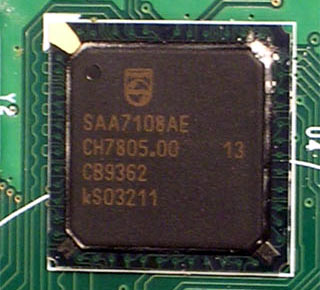
The board also offers a SAA7108AE VIVO-chip made by Philips.

Besides, on the front side of the PCB you can see a connector for additional power necessary for video cards built on NVIDIA GeForce FX 5950. Additional power doesn't have to be applied, but in this case the card would run at reduced speeds, of which it will earnestly report upon the very first boot-up of Windows. The design shortcoming of the additional power connector on MSI GeForce FX 5950 Ultra is its vertical positioning. First, it's quite difficult to apply power with an AGP video card already fitted in place. Secondly, the fastening of the connector leaves much to be desired. But that's already a problem of all FX 5900 Ultra video cards, and now NVIDIA's 5950 boards, so it doesn't make sense addressing all the claims to MSI.
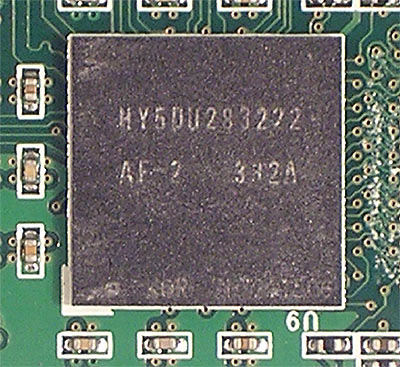
There is an advanced BGA-packaging for memory chips made by Hynix (HY5DU283222). The access time of memory chips is 2 ns, which is equivalent to 500 MHz (1000 MHz), but the memory runs at the specified 475 MHz (950) which is prescribed by NVIDIA for GeForce FX 5950 Ultra. In other words, the card offers a small margin of memory overclocking. The GPU operating speed is 475 MHz, which also meets the frequency recommended by NVIDIA.
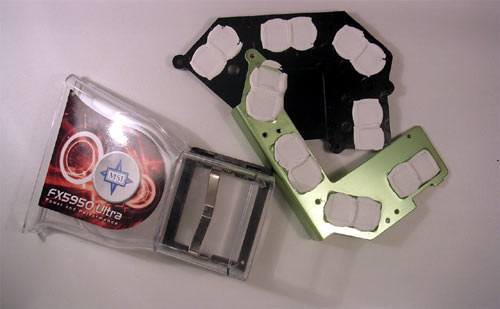
Of course we can't pass over the cooling system of the MSI GeForce FX 5950 Ultra in silence. At first glance, it may seem we have come back to FlowFX again. In fact, all is not the way it seems. Yes, the system looks clumsy and awkward, but the operating principle is already different. The air for cooling the radiator that covers the NV38 graphic chip is sucked from outside through the grid in the fastening plane of the video card.

The air entrapped by the turbine from outside is directed to the massive radiator that tightly covers the graphic chip. After the radiator is cooled by the air applied from outside falls inside the housing (already heated from the radiators). Of course this will not effect positively on the overall temperature inside the CPU unit, but the video card will always be blown about by the external cool air. The RPM rate is quite high, which makes much noise, but the noise level is much lower than that of FlowFX, and you can easily put up with it.
On top of it all, the card has pretensions of 2 slots at a time: AGP and the first PCI. The board is lengthy enough, so small-scale housings will be an issue. All the dimensions of the new NVIDIA's offspring make themselves felt.
In this benchmarking session, we were curious about comparing the performances of the new NVIDIA's flagship solution made by MSI versus the old revision of the NVIDIA GeForce FX 5900 Ultra core. For that, an ASUS V9950 video card was overclocked to the frequencies of NVIDIA GeForce FX 5950 Ultra (475 MHz / 950 MHz, marked on the graph as " GeForce FX 5900 o/c 475/950"), and the reading were taken from the boards in the overclocked mode. Let's see how justified is the statement saying that NVIDIA GeForce FX 5950 Ultra is merely the overclocking of NVIDIA GeForce FX 5900 Ultra and nothing else.
We also took test readings from an MSI FX5950 Ultra board produced with the two driver versions: ForceWare 52.16 WHQL and the most recent ForceWare 53.03, also WHQL-certified. The results for the latter are the most interesting in the FutureMark 3DMark 2003 benchmark patched with version 340, but let's not ahead - all in good time.
Test configuration:
Operating system:
We remove all the decorative "niceties" out of the Windows GUI and set the operating system to maximum performance.
Disable the Vsync forcedly via the drivers both in OpenGL and in Direct3D applications. The S3TC texture compression was also disabled.
Test software:
The video card was overclocked with the RivaTuner utility. The operation stability during overclocking was verified with Future Mark 3DMark2003 v330 and MadOnion 3DMark2001SE benchmarks. In the first of them, the third scene from Trolls' Lair in the "cycled" mode was played to reveal the overclocking potentials of the boards. On finding the critical frequencies we ran 3DMark2001SE benchmark three times. Once distortions appeared on the screen ("broken" pixels, stripes, lines etc.), then we pushed the memory frequency down by a few megahertz. If the computer hanged, we reduced the clock speed of the graphic chip. If the tests ran successfully, the overclocking was regarded as successful. We used an ordinary 8x8 cm fan as the additional cooling device that blew about the memory chips of the video card first. In our case, blown were the radiators that covered the memory chips, and that was useful considering the intense heating of the latter.
So, we were able to overclock the MSI FX5950 Ultra VTD256 video card to the following clock speeds:
| Video card | Core/memory Max |
| MSI FX5950 Ultra VTD256 | 535 MHz / 1060 MHz |
The chip was able running at higher speeds - the efficient cooling system makes itself felt, but the performance was then not increasing, but on the contrary - reducing (the so-called excessive overclocking effect), so in the end we stopped at 535 MHz / 1060 MHz. As we see, compared to the nominal 475 MHz / 950 MHz for the core/memory, respectively, the overclocking of the chip proves to be good enough, but the memory brought not so effective results. But anyway even in the nominal values for this card like FX 5950 Ultra the card runs at almost the breaking point, so it's too much demanding more from the board =).
Following the tradition, we start with the radically amended benchmarking package.
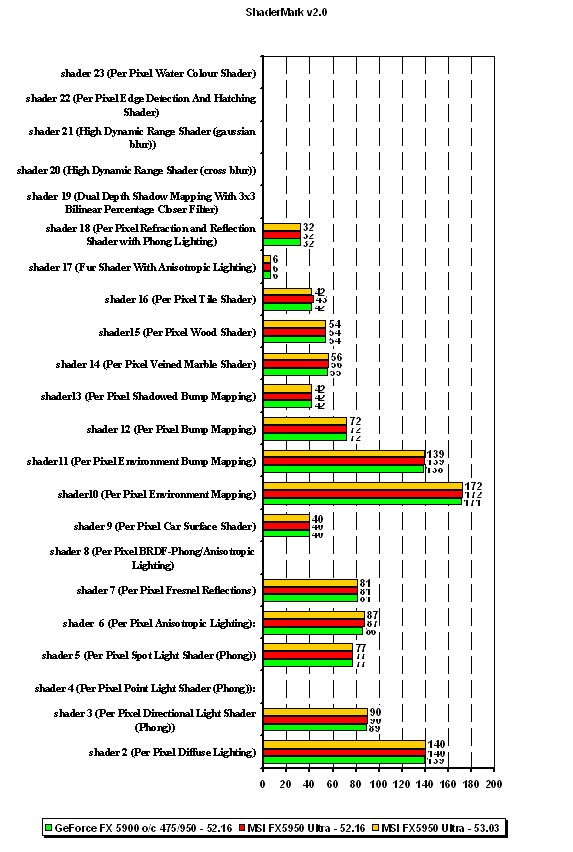
The results are predictable: no difference between the ASUS V9950 video card overclocked to the frequencies of MSI FX 5950 Ultra, nor between the MSI FX 5950 Ultra VTD256 itself. There is also no difference between the new WHQL revisions of ForceWare 53.03 and ForceWare 52.16.
This test allows to assess the speed at which the geometry is processed by the accelerator. We used the most advanced mode with three diffuse-specular light sources in combination with three different operating modes: the traditional TCL (Fixed-Function Pipeline), vertex shaders 1.1 and pixel shaders 1.1, vertex shaders 2.0 and pixel shaders 2.0.
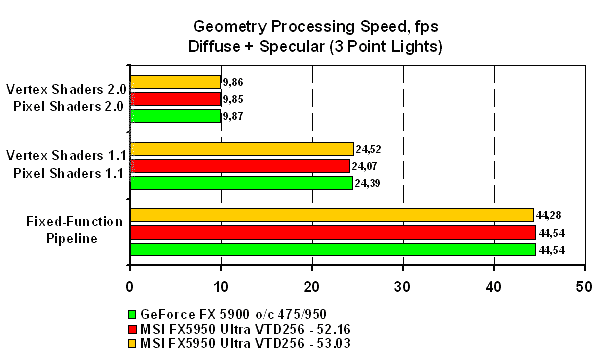
As was expected, there is an absolute similarity of results between MSI FX5950 Ultra VTD256 on ForceWare 53.03 as well as on ForceWare 52.16, and the overclocked NVIDIA GeForce FX 5900 video card.
This test performs a number of various tasks, but we were mostly interested in the possibility of measuring the performance of frame buffer filling.
We see an evident lag of NVIDIA GeForce FX 5900 o/c 475 MHz / 950 MHz from its more eminent rival MSI FX5950 Ultra VTD256, although the absolute values for all the modes differ by minimum values.
This test in the D3D RightMark benchmarking package allows to estimate the performance of executing various pixel shaders of the second version. In this test, the geometry has been substantially simplified to minimize the dependence of results of the test on the geometric performance of the chip and verify the operation of pixel pipelines only.
Again we see an absolute equality of results.
This test is aimed at revealing the accelerator speed at displaying point sprites. In the test settings, we used 2 diffuse light sources.
The result is similar to that for the previous test.
This test allows to estimate the efficiency of removal of hidden points and primitives by the accelerator.
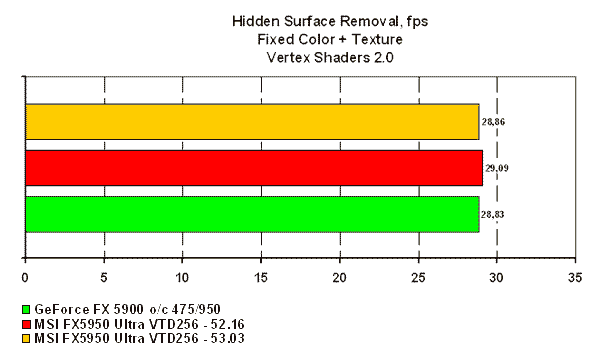
Again, a complete parity.
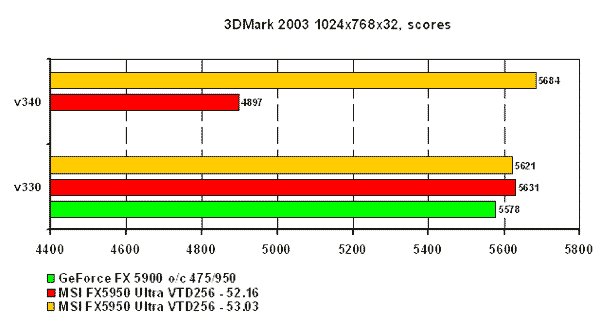
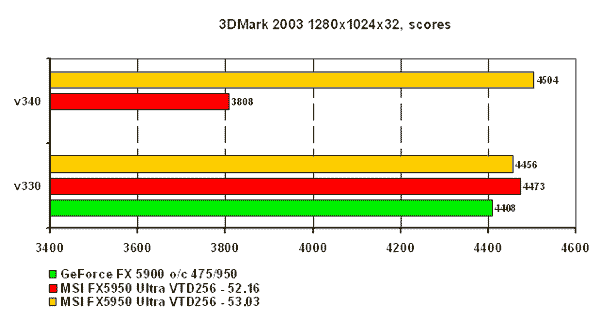
So, the synthetic tests showed that the NVIDIA GeForce FX 5950 Ultra chip brings nothing fundamentally new, but is merely an "overclock" of NVIDIA's previous-generation flagship - GeForce FX 5900 Ultra (at that, we didn't feel much doubt about that =)). Traditionally, in 3DMark 2003 we were more interested in the current situation with NVIDIA's "driver cheats" for this benchmark. We have already covered the topic of "cheats" in our review "ForceWare 52.16: NVIDIA's retaliation", as well as in our recent review "3DMark2003 build 320 vs 340: A rare moment of truth?", drew numerous parallels and analogies and discussed at length regarding the ideology of those cheats, so in this material we are not going to repeat but simply remind the readers of the current situation with those "cheats".
So, let's look into the graphs for versions 330 and 340 of 3DMark 2003. First, note the small lag of the overclocked card on the base of NVIDIA GeForce FX 5900 Ultra. We can't say if that is caused by the cheats into the benchmark for a particular device ID of the hardware, but that numerous synthetic benchmarks did not confirm a definite lag of the overclocked version of NVIDIA GeForce FX 5950 Ultra is a fact. Nevertheless, the scatter of readings is rather small. So we won't dwell on that. Secondly, note the practically identical results for ForceWare 52.16 and ForceWare 53.03 drivers.
Now let's look at the results of tests performed with the most recent patch 340. The results for the ForceWare 52.16 driver sharply drop (by around 600 points), and the WHQL-certified ForceWare 53.03 release soon afterwards amends the situation radically. As we'll see later on, the issue is amended only in 3DMark 2003 - at gaming benchmarks the new driver doesn't show any performance boost, but we are already used to that. For now, the new ForceWare 53.03 hasn't yet been added to the list of drivers "approved" by FutureMark. Perhaps FutureMark is preparing a new patch to approve this release of drivers? =)
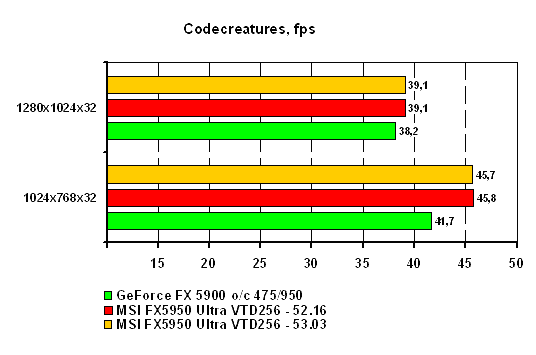
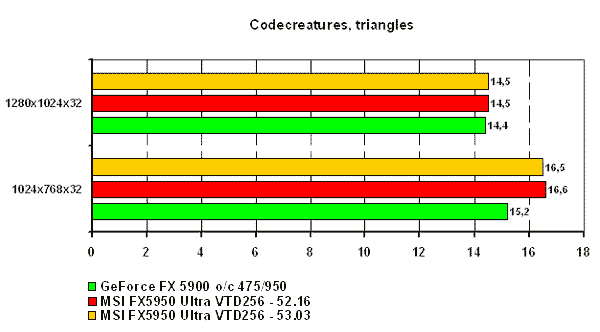
This benchmark shows a slight lag of NVIDIA GeForce FX 5900 overclocked to the speeds of MSI FX5950 Ultra VTD256 and a predictable equality of results for both versions of the ForceWare drivers.
From synthetic applications, we are now moving on to analyzing the performance of the graphic boards in real gaming applications.
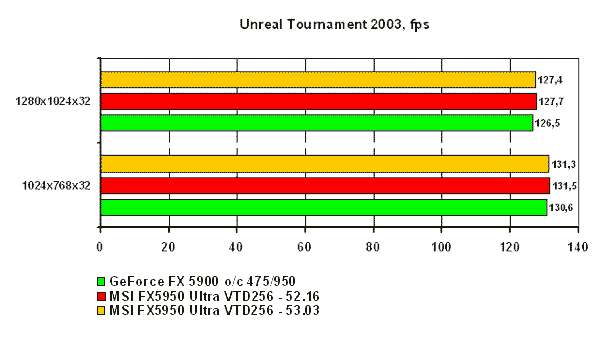
The anticipated absolute equality of results for the three cases has been achieved.
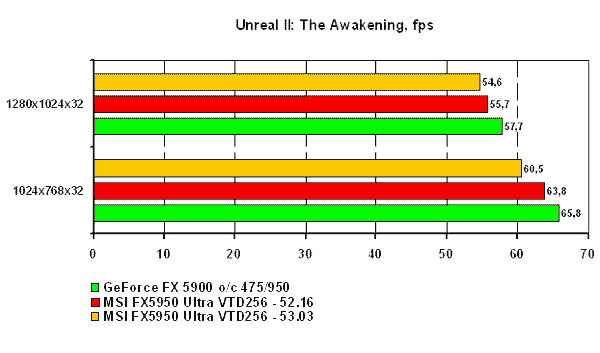
At that, the situation is even more interesting. The overclocked NVIDIA GeForce FX 5900 board leaves the counterparts well behind. You can also see a definite lag of the 53.03 driver as compared to 52.16.
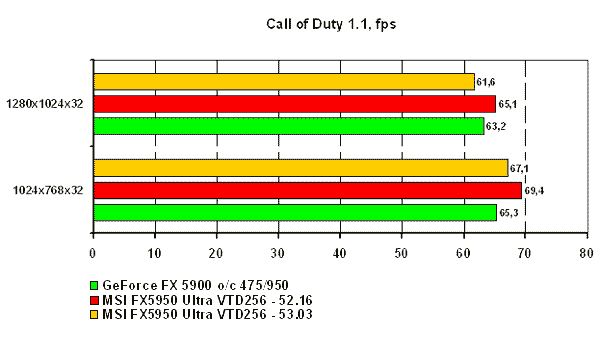
In our new gaming benchmark which we'll use instead of Return to Castle Wolfenstein onwards, Call of Duty also uses the modified engine Quake 3: Arena, we can observe a small lag of the NVIDIA GeForce FX 5900 board, as well as a small gain achieved by MSI FX5950 Ultra VTD256 based on the ForceWare 52.16 driver.
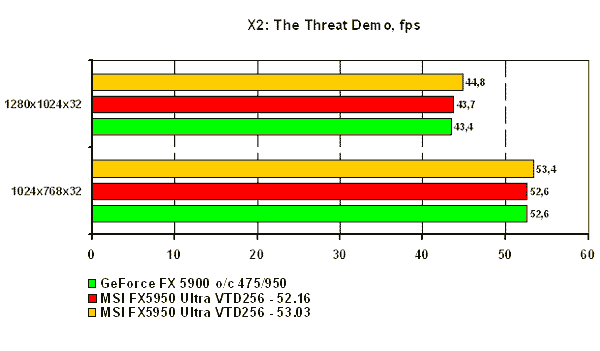
There is a small advantage achieved by the new ForceWare 53.03 driver.
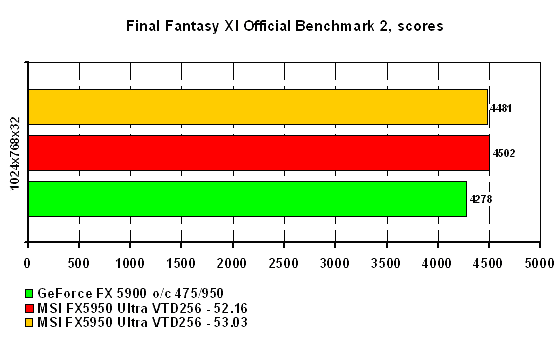
A definite noticeable lag of the "overclocked FX 5950 Ultra".
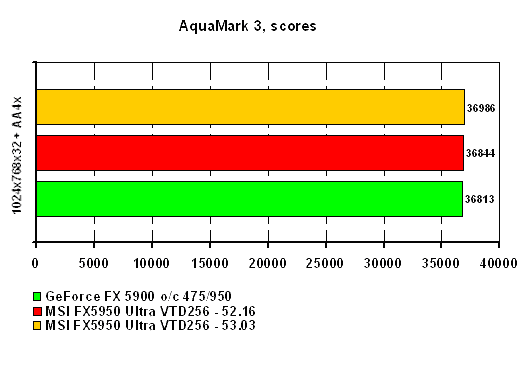
A complete parity on all fronts.
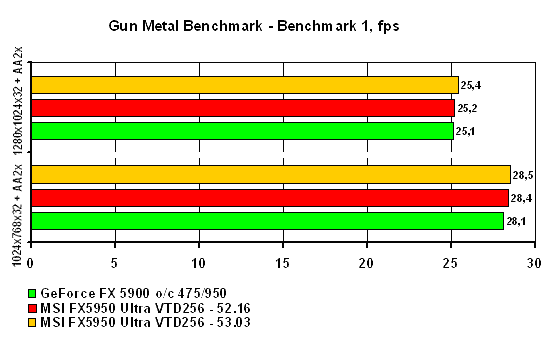
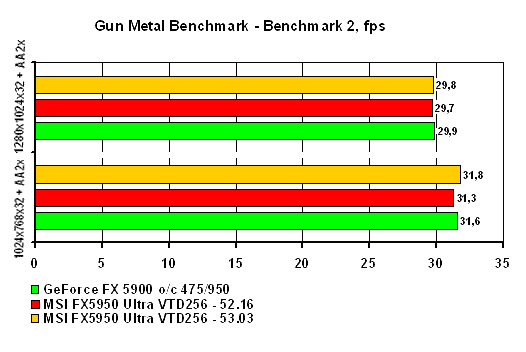
Like in the previous test, a compete parity on all fronts.
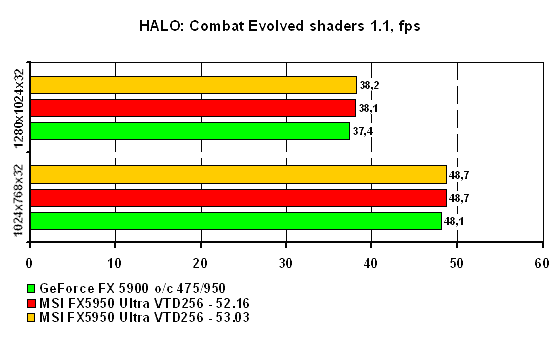
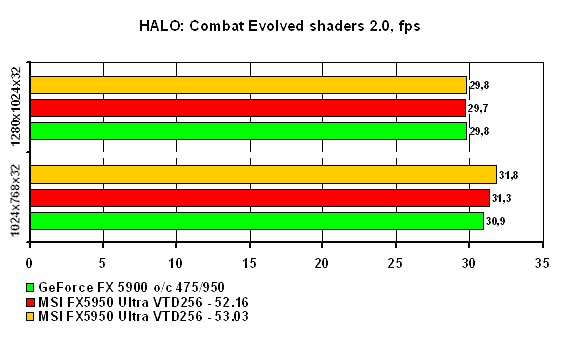
The differences in results can be safely attributed to the measurement error.
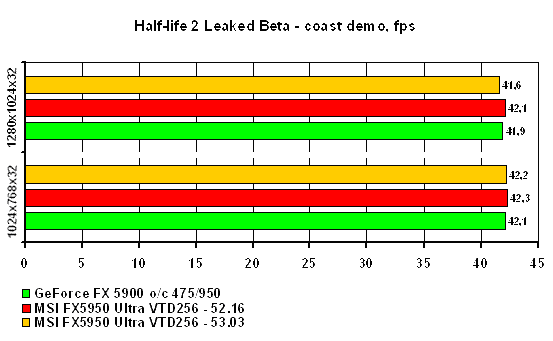
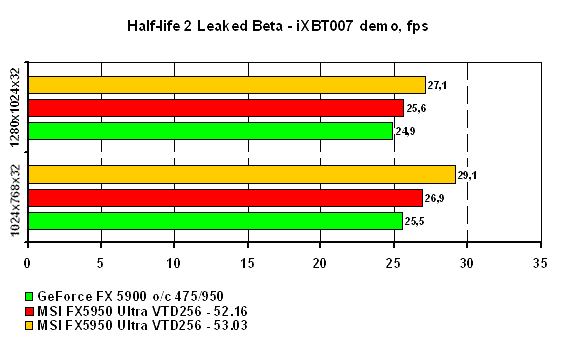
But Half-life 2 demonstrates a quite noticeable gain with ForceWare 53.03.
Tests of the new NVIDIA GeForce FX 5950 Ultra (NV38) chip have shown that we get an absolutely the same NV35 but which has undergone a more thorough screening for operation at higher speeds. Our tests have shown that if we average the results, then we see that the same performance level as in video cards built on the NV38 can be obtained through overclocking a regular card built on the NVIDIA GeForce FX 5900 chip, which is logical because no architectural novelties have been implemented in NV38. The performance boost attained due to "overclocking the NV35" is of course attained, but in most cases this is not what is anticipated from NVIDIA. Currently, the company does need a new chip and, as it seems to us, it will be made in full conformity with the HLSV architecture (forget about the Cg) because the Canadian rival is now taking stronger positions. What is left to us is merely have a look at tests of the new NVIDIA's flagship solution implemented by MSI, then look at the prices, breathe in deeply and patiently wait for NV40 =).
Regarding the MSI FX5950 Ultra VTD256 board. An excellent product with a remarkable package bundle (traditional for MSI). MSI FX5950 Ultra VTD256 appears to be a complete replica of the reference design, and implementation of such complex PCB like that in NVIDIA GeForce FX 5950 Ultra is the most optimum solution. Despite the operation of the NV38 chip at the extreme speed, the MSI FX 5950 Ultra VTD256 board shows quite good overclocking results. What is left to the end users (who are not so many for this goods because of its extremely high price) is to be guided first by the product price offered by other manufacturers, since other manufacturers are very unlikely to make something out of the ordinary with graphic boards built on the NVIDIA GeForce FX 5950 Ultra. In this case, subjective factors like the brand name of the manufacturer and the package bundle come into play. At that, MSI has every reason to be a good buy.
MSI GeForce FX 5950 Ultra was presented by 3Logic.
![]() Discussions of drivers for ATI video cards (2 3 4 5 6 7 ... 10 11)
Discussions of drivers for ATI video cards (2 3 4 5 6 7 ... 10 11)
|
|||||